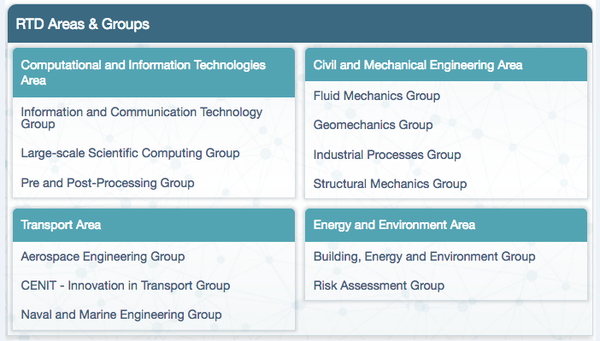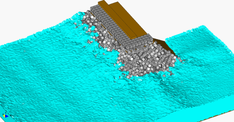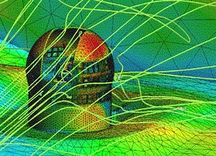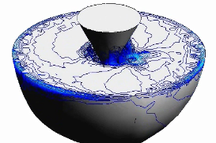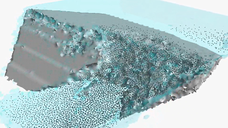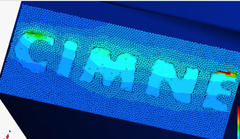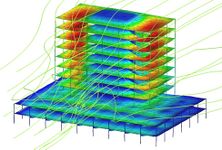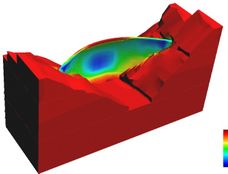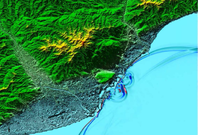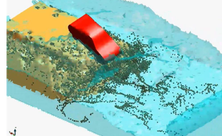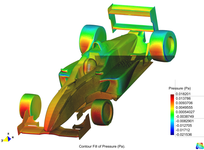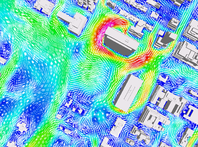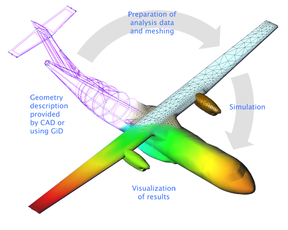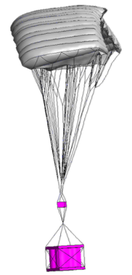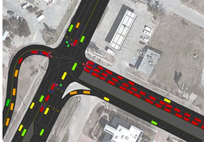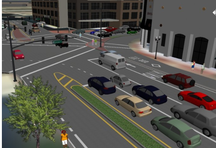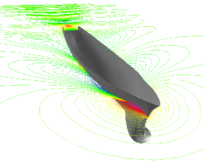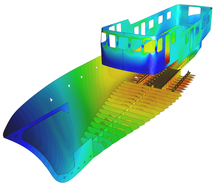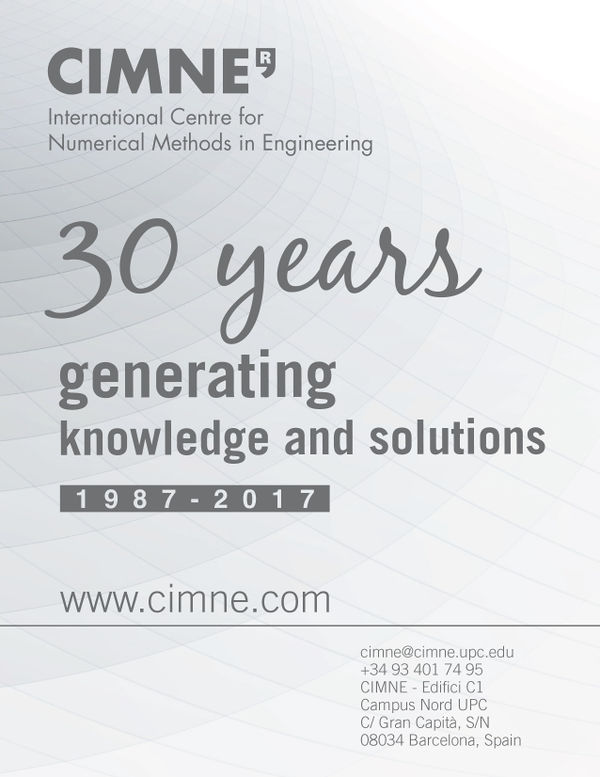m (Move page script moved page Draft Samper 628841228 to Onate 2017b) |
|
(No difference)
| |
Latest revision as of 09:57, 10 July 2019
ABSTRACT
We present an overview of the model implemented by the International Centre for Numerical Methods in Engineering (CIMNE, www.cimne.com ) for the generation of scientific and technical knowledge on computational engineering, understood in the broad sense, the subsequent generation of product resulting from the research activities and the transfer of these products to society for their exploitation in the industrial sector.
We present examples of application of the CIMNE model to a number of academic, scientific and industry activities of CIMNE .
1. OVERVIEW OF CIMNE
1.1. CIMNE mission
The International Center for Numerical Methods in Engineering (CIMNE) was created in 1987. Its mission is the development and dissemination of original research in the field of numerical methods in engineering (NME), the education of researchers and engineers and the transfer of its research outputs to industry.
NME is the discipline that provides the scientific basis for the computer analysis of all engineered systems. Researchers on NME require outstanding skills on mathematical modelling, engineering concepts, numerical algorithms and programming.
The NME field was created in 1969 when the International Journal for NME (Wiley) was created by initiative of the prestigious Prof OC Zienkiewicz (FRS), a visiting scientist in CIMNE for 20 years until his death in 2009 (https://en.wikipedia.org/wiki/Olgierd_Zienkiewicz). Nowadays there are some 30 international scientific journals related to NME. Research fields analogous to NME are Computational Engineering (CE) and Computational Mechanics (CM). These three fields have led in the last 40 years to the creation of several international scientific societies.
CIMNE is a leader as an international Center of Excellence in the field of NME through five main action vectors:
- 1. Excellence in research on NME for multidisciplinary engineering applications.
- 2. International dimension
- 3. Participation in the management of scientific societies
- 4. Commitment with the transformation of scientific knowledge into useful products
- 5. Active engagement on technology transfer to industry
Since 1987 CIMNE has evolved to become a prestigious international research center on NME. Its research staff (90% of whom are engineers) includes (by October 2017) some 200 researchers, some of whom are faculty members of the prestigious Technical University of Catalonia (UPC, www.upc.edu ). These distinguished affiliated researchers play an important role as liaison between research groups in UPC and CIMNE.
1.2. Research and technology development activities at CIMNE
The research and technology development (RTD) activities of CIMNE cover a wide spectrum of topics of interest in classical engineering fields such as civil, mechanical, aeronautical, environmental, naval, and marine, food, telecommunication, energy efficiency and fresh water production. CIMNE research also shares links and applications with many applied sciences such as material sciences, bio-mechanics, computational physics, natural, social and economic sciences, computer sciences and multimedia and information and communication sciences, among others.
Research activities in CIMNE are structured in research lines (RLs) covering several challenging topics on computational engineering and related areas. We list below the ten outstanding RLs of CIMNE. For each one we give the coordinator and the main research topics. The scope of each RL adapts to the specific requirements and challenges defined by industry and society.
RL1: ALGORITHMS FOR MULTIPHYSICS PROBLEMS. Coordinator: S. Idelsohn
Numerical methods for complex coupled problems such as fluid-soil-structure interaction, aero-acoustics, electromagnetics, magneto-hydrodynamics and atmospheric/thermal flows.
RL2: COMPUTATIONAL FLUID DYNAMICS. Coordinator: R. Codina
Numerical methods for incompressible and compressible flows. Applications to internal and external flows, free-surface flows, multifluids, flow in porous media, aerodynamics and acoustics.
RL3: COMPUTATIONAL GEOMECHANICS. Coordinator: A. Gens
FEM and particle methods for dry, saturated and partially saturated soils and rocks. Applications to geotechnical engineering: foundations, underground structures, tunnels, dams and slopes.
RL4: MATHEMATICAL AND COMPUTATIONAL MODELING. Coordinator: R. Huerta
Mathematical models and algorithms for error estimation, mesh adaption and quality of the numerical solution. Reduced order models for (quasi) real time solution of complex engineering systems.
RL5: COMPUTATIONAL MODELLING OF ENGNG MATERIALS. Coordinator: X. Oliver
Methods for multiscale analysis of materials & structures. Applications to the design of new functional materials.
RL6: COMPUTATIONAL SOLID & STRUCTURAL MECHANICS. Coordinator: E. Oñate.
FEM and particle-based procedures for linear and nonlinear analysis of solids and structures. Applications to most engineering fields.
RL7: OPTIMIZATION. Coordinator: G. Bugeda
Robust optimization procedures for shape and material design and process optimization in civil, mechanical, aerospace and naval engineering.
RL8: COMPUTATION AND INFORMATION TECHNOLOGIES. Coordinator A. Coll.
Methods for mesh generation and visualization of huge sets of numerical results in parallel computers using data mining and cloud storage techniques. Integration of decision support systems in engineering.
RL9: NUMERICAL METHODS AND TECHNOLOGIES FOR ENERGY AND
ENVIRONMENT. Coordinator: A. Barbat
Holistic risk prediction & risk management of constructions and landscape under natural, technological and man-made hazards. Methods for fresh water production. Energy management & reduction for buildings and individual users.
RL10: TRANSPORT SYSTEM ANALYSIS. Coordinator: S. Saurí
Urban mobility, traffic models, port logistics and maritime transport, transport
infrastructure management, resilience of transport networks to hazards.
For more details of CIMNE research lines visit http://www.cimne.com/vpage/2/0/Research/Research-lines-areas-groups
1.3. Organization of research at CIMNE
Researchers at CIMNE carry out their activity within research and technical development (RTD). Groups managed by a Group Leader. The research activities are coordinated by one or more Principal Investigators (PIs). It is common that researchers from different RTD Groups contribute to a same RL.
For a better visibility of the research, RTD Groups are gathered in RTD Areas that target fields such as civil & mechanical engineering, transport, energy & environment and computational and information technologies.
Figure 1 below shows a panoramic view of the current Research Lines, RTD Areas and RTD Groups at CIMNE. The structure and activities of the RTD Areas and RTD Groups listed can be seen in http://www.cimne.com/vpage/2/0/Research/Research-lines-areas-groups .
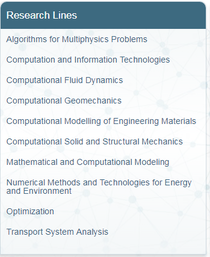
|
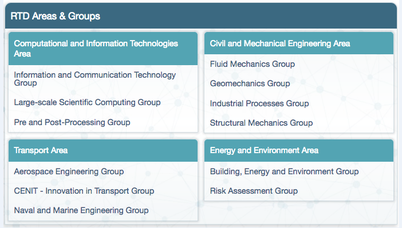
|
| Figure 1. Research Lines, RTD Areas and RTD groups at CIMNE | |
1.4. Practical impact of CIMNE research
The priorities of CIMNE for research excellence target the development of new NM and software codes in order to help engineers to better predict, design and optimize systems affecting our lives, including our environment, our security and safety, and the products we use and export.
CIMNE research aims to breakthroughs on next-generation numerical methods and software for solving selected engineering problems of practical interest, and in particular those problems aligned with the priorities of the H2020 program of the European Comission in the areas of MANUFACTURING, TRANSPORT, ENVIRONMENT and SECURITY.
More specifically, the research activities in CIMNE are addressed to solving the following challenging practical problems:
- Better design of forming manufacturing processes and products.
- Design of aircrafts with improved performance and environmental features.
- Design of next generation ships and marine structures.
- Assement of the effect of natural hazards (floods, earthquakes, landslides, etc) on constructions and the environment.
- Assesment of the effect of technological and human-induced hazards on constructions and citizens.
- Efficient management of energy and water resources
- New computational technologies and integrated systems for Predictive Territory Management.
- Innovative fresh water production systems
The solution of the engineering problems addressed at CIMNE can only be attempted with enough confidence from an interdisciplinary perspective, i.e. accounting for all the complexities and couplings introduced by the different physical fields involved.
This situation explains the transversal character of the research activities of CIMNE that typically share topics from several RLs. Some examples: the analysis of a construction under flooding or tsunami forces, the aeroelastic analysis of an aircraft wing or the optimization of an industrial forming process requires knowledge and techniques emanating from several research activities developed at CIMNE.
Consistently with these broad goals, research progress at CIMNE requires the synergic work of interdisciplinary teams with the necessary critical mass. With the depth of these intellectual developments and their wide range of applications, the numerical methods and codes developed at CIMNE have emerged as powerful tools for solving a wide range of engineering problems and have helped to making of CIMNE a worldwide reference in the computational engineering field.
1.5. Participation in RTD projects
Since 1987 CIMNE researchers have taken part part in some 2000 RTD projects (including 10 research projects funded by the prestigious European Research Council, https://erc.europa.eu/ ). Information of recent relevant CIMNE RTD projects is given in Annex 2. The list of on ongoing and past CIMNE RTD projects can be found in http://www.cimne.com/vpage/2/0/Research/Projects/Ongoing .
1.6. Holistic view of CIMNE RTD activities
The overall RTD mission of CIMNE has evolved over the years towards providing comprehensive solutions for solving problems that affect human beings. This can be achieved by integrating existing knowledge in a particular field with quantitative information emanating for prediction methods (i.e. computational-based techniques) and experimental measurements. The link between these four concepts: the problem to be solved, computational methods, experimental methods and existing knowledge is well represented by, the so-called at CIMNE, the RTD tetrahedron shown in Figure 2.
Each node in the tetrahedron is connected to the other three by lines that represent information pipelines (possibly internet). The intensity of the flow along the lines that interconnect two nodes would vary depending on the requirements for solving the problem.
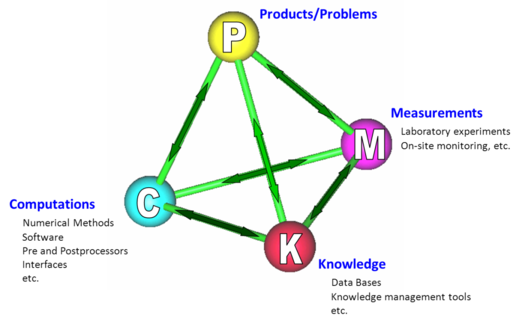
|
| Figure 2. The RTD tetrahedron at CIMNE linking problems, computations, measurements and knowledge |
2. CIMNE RESEARCH OUTPUTS
Research at CIMNE has lead to a number of software codes and integrated systems that are useful for solving specific problems in a wide range of engineering áreas. Annex 3 lists the main software codes and other products developed at CIMNE.
2.1. Publications
CIMNE researchers publish in the best journals listed in the prestigious Journal Citation Reports (JCR) in the fields of civil and structural engineering, geotechnical engineering, engineering geology, computational mechanics and computational mathematics, among others.
Since 1987 CIMNE researchers have published 2500 JCR journal papers, 46 text books, 82 edited books, 250 monographs, 415 RTD reports, 643 technical reports and organized 210 international scientific conferences (Annex 10). CIMNE has 7 patents (See Annex 3).
CIMNE scientists are chief editors or associated editors of 6 international JCR journals and members of the editorial board of 15 JCR journals.
CIMNE has its own Publications Department that publishes books, journals, monographs, scientific reports and educational software on the theory and applications of numerical methods in engineering and applied science. For details see http://www.cimne.com/vpage/2/0/Publications/Bookstore
2.2. Journals published by CIMNE
CIMNE publishes two journals listed in the JCR.
- ARCHIVES OF COMPUTATIONAL METHODS IN ENGINEERING, a quarterly journal edited by M. Kleiber (Polish Academy of Sciences) and E. Oñate (CIMNE). ACME has been published by CIMNE since 1994 and by Springer since 2007. Impact Factor (2016): IF= 5.061, 5-Year IF: 5.710. ACME is nowadays the leading journal in the NME field. It is ranked 1 of 101 in category “Mathematics, Interdisciplinary Applications”, 2 of 85 in category “Engineering Multidisciplinary”, and 5 of 104 in category “Computer Science, Interdisciplinary Applications” (Source: JCR)
- REVISTA INTERNACIONAL DE MÉTODOS NUMÉRICOS PARA CÁLCULO Y DISEÑO EN INGENIERÍA, a quarterly journal edited by E. Oñate (CIMNE) and S. Idelsohn (Full Professor at CIMNE) published in Spanish and Portuguese by CIMNE since 1985 (it celebrated its 30th anniversary in 2015). This is the only journal in the Ibero-American community in the NME field. The journal entered in the JCR databases in 2010. Since May 2017 it is published in Open access by Scipedia (https://www.scipedia.com/sj/rimni). Impact Factor (2016): IF= 0.431, 5-Year IF: 0.345 (Source: JCR).
2.3. Journals edited by CIMNE scientists
In addition of the two CIMNE journals mentioned above, E. Oñate is co-chief editor of COMPUTATIONAL PARTICLE MECHANICS. This is a quarterly Springer journal covering an emerging scientific and technical field (the world of particles of all sizes and their applications) with broad industrial impact. The journal is co-edited by T. Zhodi (Univ. California, Berkeley), E. Oñate (CIMNE) and P Wriggers (Univ Hannover). The first issue was published in 2014 and, hence, it is not ranked yet by the JCR. The journal is a partner of the international conferences on Particle-based Methods. Fundamentals and Applications organized by CIMNE since 2009. The 5th conference of the series was held in Hannover on September 26-28, 2017, http://congress.cimne.com/particles2017/frontal/default.asp.
E. Oñate is also Associated Editor of the journal COMPUTER ASSISTED MECHANICS published by the Institute for Fundamental Technological Research of the Polish Academy of Sciences. The journal is published under the auspices of ECCOMAS after an initiative of E. Oñate when he was president of ECCOMAS in the period 2000-2004.
E. Alonso was appointed in January 2015 Honorary Editor of GÉOTECHNIQUE by the UK Institution of Civil Engineers.
A. Huerta is an Associate Editor of ADVANCED MODELING AND SIMULATION IN ENGINEERING SCIENCES”, Springer Open Journal, since 2013 and of the INTERNAT. JOURNAL FOR NUMERICAL METHODS IN ENGINEERING (Wiley) since July 2015.
A. Barbat, A. Huerta and X. Oliver are Associated Editors of the Revista Internacional de Métodos Numéricos en Ingeniería, Elsevier, since 2011.
Several CIMNE researchers are members of Editorial Boards of international journals in the NME field, some of which we list here: Engng Computations (Oñate), Int. J. for Num Meth in Engng (Oñate, Huerta, Idelsohn), Int. J. for Num Meth in Fluids (Idelshon, Huerta), Computational Mechanics (Oñate), Computer Methods in Applied Mechanics and Engineering (Oñate, Idelsohn), Int. J. of Forming Processes (Oñate, Idelsohn), Computers and Structures (Oñate), Archives of Comp Meth in Engng (Oñate, Idelsohn, Oliver, Huerta, Gens), Finite Elements in Analysis and Design (Oñate); Applied Mathematics and Computation (Badia), Advanced Modeling and Simulation in Engineering Sciences (Codina, Diez, Idelsohn, Oliver, Oñate).
2.4. The SCIPEDIA platform for communicating science
In 2016, CIMNE promoted the creation of SCIPEDIA S.L. (www.scipedia.com ), a spin-off company created with the aim of making research publications more reachable for the scientific and engineering community.
SCIPEDIA fosters the publication and dissemination of documents in Open Access format under the Creative Commons BY-NC-SA license. Scipedia creates and manages journals and collections of publications of individuals and groups (eg. a single author, a group of academics, a university department or a research center, etc).
Scipedia embraces new technologies to effectively generate and provide enriched content. Scipedia offers a superior online platform for visual edition of papers, including importation utilities from LaTeX or Microsoft Word, comments and discussions support, etc. Furthermore, Scipedia’s platform accepts supplementary material to enhance scientific publications. This includes video material, animation sequences, datasets, spreadsheets, computational models and more. The innovative features of Scipedia can be seen in https://www.scipedia.com/
3. EDUCATION ACTIVITIES, CITATION RECORDS AND AWARDS
3.1. Education activities of CIMNE
Since 1987 CIMNE has managed 2 international MSc courses and 2 PhD programs in the field of computational engineering sciences. http://www.cimne.com/vpage/2/0/Training/Post-Graduate
CIMNE organises an average of 2 short courses and 23 seminars annually. http://www.cimne.com/vpage/2/0/Training/Seminars-n-Courses.
CIMNE researchers also regularly organize informal lectures, named CIMNE Coffee Talks, www.cimne.com/coffee-talks, covering different scientific topics in an informal format.
CIMNE scientists have supervised a total of 160 PhDs and some 720 MSc students.
3.2. Citation records of CIMNE researchres
By March 29, 2017 CIMNE scientists as a whole had an h index of 109 and over 54000 citations (h=72 and some 28000 citations since 2012); Source: Google Scholar https://scholar.google.es/citations?hl=es&user=7ZrIPS4AAAAJ&view_op=list_works&is_public_preview=1 .
On January 2017 CIMNE was ranked best research centre in Spain on Mathematics & Interdisciplinary Applications by the Group for the Dissemination of the h Index. Several CIMNE researchers are ranked in the first positions in that area and others of engineering (refer to (http://indice-h.webcindario.com/ for more information of CIMNE benchmarking).
3.3. Awards to CIMNE and its scientists
Since 1987 CIMNE and its scientists have received some 70 awards by national and international organizations. The list of CIMNE Awards can be seen in http://www.cimne.com/vpage/2/0/About/Awards
As an example, in the last five years several CIMNE scientists received distinctions including three prestigeous Advanced Grants from the European Research Council (ERC) (S. Idelsohn, E. Oñate and J. Oliver), 2 ERC Starting Grants (S. Badia and M. Arroyo), 5 ERC Proofs of Concept (S. Idelsohn, J. Oliver, E. Oñate (2), and S. Badia (2)) and 5 Honorary Doctorates to the following CIMNE scientists:
- E. Oñate (2: University "Marta Abreu" of Las Villas in Santa Clara, CUBA; Institut National des Sciences Appliquées (INSA, FRANCE),
- A. Gens (Université de Grenoble - Joseph Fourier, FRANCE),
- A. Barbat (Technical University "Gh. Asachi" of Iasi, ROMANIA; Technical University of Cluj-Napoca, ROMANIA).
4. INTERNATIONAL PRESENCE OF CIMNE
4.1. Internacional CIMNE branches and joint labs
In 2005 CIMNE started its international expansion and since then has created CIMNE Latin-America (Non-profit Foundation in Santa Fe, Argentina) and CIMNE USA (Non-profit Corporation in Washington DC, USA).
CIMNE has close links with several prestigeous universities and RTD organizations worldwide (see Annex 4).
CIMNE has also established a network of 30 CIMNE Classrooms (Joint Labs) in partnership with Universities in Spain and 11 Latin American countries. This is the largest network in the field of computational engineering in the world. Each member of the network provides physical spaces and qualified staff for the development of training, RTD and technology transfer activities in cooperation with CIMNE and other members of the network.The list of CIMNE Classrooms can be found in http://aulas.cimne.com/spacehome/3/0).
4.2. Management of Scientific Organizations
CIMNE is the permanent Secretariat of the following scientific organizations:
- International Association for Computational mechanics (www.iacm.info),
- European Community on Computational Methods in Applied Sciences (www.eccomas.org)
- Spanish Association for Numerical methods in Engineering (www.semni.org ).
- Pilot Centre of the European Research Community in Flow, Turbulence and Combustion (www.cimne.com/Sociedades/ercoftac/home.htm
- Unesco Chair on Numerical Methods in Engineering of UPC (www.cimne.com/websasp/unesco/default.asp). This is the first UNESCO Chair in the world, created in 1989.
4.3. Organization of international scientific events
Since its early years of existence, CIMNE created a professional Scientific Congress Bureau (http://congress.cimne.com/web/ . This has allowed CIMNE to organise some 200 international conferences in the NME field since 1987. CIMNE typically offers the organisation of conferences as a service to the CIMNE community, as well as to other research centres, companies and universities worldwide.
The CIMNE conferences are excellent occasions for disseminating CIMNE research outputs, as well as for acquiring new knowledge and for creating opportunities for participating in new RTD projects and networking with international researchers and industry.
The full list of the international events organized by CIMNE is listed in http://www.cimne.com/vpage/2/0/Events/Conferences .
We following table summarises the 52 international scientific conferences organized by CIMNE in the period 2012-2016, showing the place/region where the event was held:
| Barcelona | Other cities in Spain | Europe | Rest of the world | TOTAL | |
| 2012 | 7 | 1 | 1 | 0 | 9 |
| 2013 | 5 | 5 | 5 | 2 | 17 |
| 2014 | 6 | 2 | 2 | 0 | 10 |
| 2015 | 6 | 0 | 4 | 1 | 11 |
| 2016 | 2 | 2 | 1 | 0 | 5 |
| TOTAL | 26 | 10 | 13 | 3 | 52 |
We list below a selection of the 52 international scientific conferences organized by CIMNE in 2012-2016. The participation of relevant CIMNE researchers as co-chairs of the conferences is highlighted.
- 11th World Congress on Computational Mechanics, held in conjunction with the 5th European Conference on Computational Mechanics and the 6th European Conference on Computational Fluid Dynamics. Co-Chaired by E. Oñate, X. Oliver and A. Huerta (Barcelona 2014) http://congress.cimne.com/iacm-eccomas2014/frontal/default.asp
- 1st Pan American Conference on Computational Mechanics. Co-Chaired by S. Idelsohn (Buenos Aires 2015) http://congress.cimne.com/panacm2015/frontal/
- Computational Plasticity. Co-Chaired by E. Oñate (Barcelona 2013, 2015, 2017) http://congress.cimne.com/complas2017/frontal/default.asp
- Computational Methods for Coupled Problems in Engineering. Co-Chaired by E. Oñate (Ibiza 2013, Venice 2015, Rhodes Island 2017)
http://congress.cimne.com/coupled2017/frontal/default.asp
- Computational Methods in Marine Engineering. Co-Chaired by E. Oñate (Hannover 2013, Rome 2015, Nantes 2017) http://congress.cimne.com/marine2017/frontal/default.asp
- Textile Composites and Inflatable Structures. Co-Chaired by E. Oñate (Munich 2013, Barcelona 2015, Munich 2017) http://congress.cimne.com/membranes2017/frontal/default.asp
- Adaptive Modelling and Simulation. Co-Chaired by P. Diez (Nantes 2015, Verbania (Italy) 2017) http://congress.cimne.com/admos2017/frontal/default.asp
- Advances of GiD (Barcelona 2012, 2014, 2016) https://www.gidhome.com/gid-convention/gid-convention-2016/
- Particle-Based Methods. Co-Chaired by E. Oñate. Barcelona, 2013, 2015, Hannover 2017) http://congress.cimne.com/particles2017/frontal/default.asp

|
| Figure 3. Innauguration of WCCM-ECCM-ECFD Congress, Barcelona 22-24 July, 2014 http://congress.cimne.com/iacm-eccomas2014/frontal/default.asp |
4.4. Social networks
In recent years, CIMNE has put effort in the dissemination ot its different activities via social networks to reach a broader audience.
The Twitter account @cimne has some 800 followers.
CIMNE also has a LinkedIn account. From 2016 this account has been actively and increasingly used to communicate relevant CIMNE news to the community.
CIMNE news are also regularly disseminated via the News Section of the corporative web site www.cimne.com
The CIMNE Multimedia Channel (www.cimnemultimediachannel.com ) is a repository of the educational, scientific and social videos produced at CIMNE.
The CIMNE YouTube Channel t disseminates corporative information, demos, conferences and CIMNE products, among other CIMNE activities. It has over 650 followers https://www.youtube.com/channel/UC0TGuKQ2aeugQ-ClOGT4W9A
5. CIMNE. A SELF-SUSTAINED ORGANIZATION
CIMNE has implemented an (almost) self-sustainable financial model with limited annual public funding from the Government. This has been possible by its active policy for obtaining income from RTD projects funded by public and private international and national organizations and industry, revenues from the CIMNE spin-off companies and an efficient management structure.
Figures 4 and 5 below show the evolution of CIMNE income and the percentage of public funding received since 1987. Note that CIMNE has received just some 5% average annual public funding in the period 1987-2017.
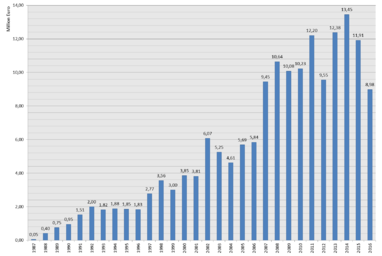
|
| Figure 4. Evolution of CIMNE income |
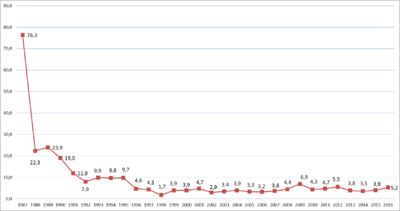
|
| Figure 5. Evolution of percentage of public funding by the Govermnent |
Figure 6 show the source of CIMNE income in the period 2010-2016. Income originates from contracts with industry, European and international RTD competitive RTD projects, National competitive RTD projetcs, conferencves and courses, grant from the Catalonian Govermment (Generalitat de Catalunya), financial revenues and others (sells of CIMNE companies, technology licenses, etc).
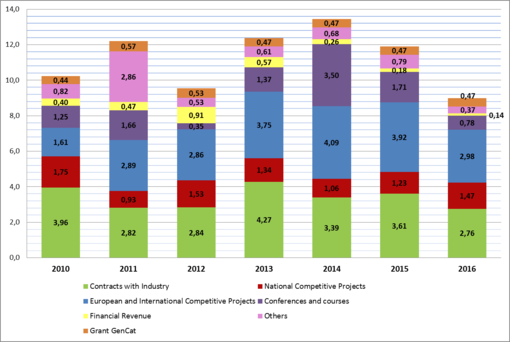
|
| Figure 6. Source of CIMNE income in 2010-2016. Figures in million Euro |
6. CIMNE STRATEGY FOR TRANSFORMING KNOWLEDGE INTO PRODUCTS
6.1 The Cycle of Ideas at CIMNE
When people talks about research, development and technology transfer to society (RTD in short) and commercial industrial activities, it is quite usual to mix up objectives, resources and responsibilities. There is a growing opinion, spread by some public administrators and the media, that research groups at universities and RTD centers must be "profitable". In few words, many persons would wish that research is funded with competitive funds or even loans (either public or private) and that the outcomes of the research get fast into the market, so that the profits from marketing products will allow research groups to be financially self-sustaining.
It is also usually argued that companies should increase their research activity and invest more resources in finding new discoveries. The humoristic limit of this situation is pretending that companies will produce Nobel laureates and that a research group would be among the 10 first positions in the ranking of economic organizations in a country. Certainly, both these situations are not impossible, although they are highly improbable. The opposite case is, unfortunately, more frequent, i.e. that researchers compelled by their needs to guarantee the financial survival of their groups, abandon or considerably reduce their fundamental research activities, and that companies, confusing what is a Technical Department with an Innovation Department, consider themselves self-sufficient in terms of their capacity for innovating and underestimate or ignore the contact with the RTD world in research centers and universities.
How the Cycle of Ideas works at CIMNE
Above concepts can be clarified if we examine what we call at CIMNE the Cycle of Ideas. Figure 7 shows a scheme of the transit of an idea, from the instant it originates until it is transformed in an industrial and commercial success. Similarly, as it happens in other biological environmental cycles (the water cycle or the cycle of plants, for instance), the cadencies and tempos are very important and their perturbation can lead to negative results.
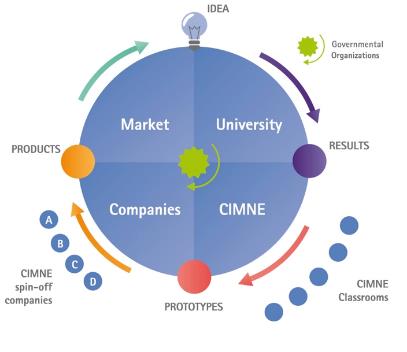
|
| Figure 7. The Cycle of Ideas at CIMNE |
Ideas (and I basically refer here to scientific advances) usually originate in university environments, where many professionals have the mission of thinking, studying, investigating and eventually discovering new areas of knowledge. The idea (the new discovery) would be equivalent to a seed, in the sense that even being very important (essential) it is far from becoming a fruit.
The idea matures in its "tour" by the first quadrant of the Cycle (the University) until it produces tangible results (thesis, papers, computer programs, physical devices, etc.). These "results", if they are not filed and protected, can be easily lost. This leads to undesirable repetitions or duplications.
What to do then with the results of an idea? The best is that they can evolve until they reach the level of a prototype; ie. until they became something (a software code, a system, a device, etc.) that works in a contrastable manner in the hands of a person different from the author. The transit of a result to a prototype is not a trivial one and it demands an organization, efficient and capable staff and resources that are usually far from the ordinary means of a university group. The best alternative is, therefore, that the idea follows its route on specialized institutions, adjacent to the university, with the specific mission to transform knowledge into tangible things (prototypes).
Many organizations of this type have been created worldide in the last years. CIMNE is an example. Some of these organizations are called Research Centers and others Innovation Centers. This terminology is sometimes deceiving, as it apparently indicates that some centers must focus in research and not in technology transfer, and vice-versa. The truth is that research and technological development are essential activities in both type of, what we could call, RTD centers. What is important is that RTD centers must have the capability of teaming up with research and industry environments with a practical vision.
University and enterprise
Can a prototype be released into the market with a guarantee of success? The answer is (probably) no. The distance between a prototype and a product is typically a long one. Getting a product is an objective in itself and mixing it up with RTD tasks is not advisable and leads to frustrations. Products should be developed in companies where specialists devote their time and talent exclusively to obtaining, validating and documenting a product, as well as to defining the marketing plan. The list of CIMNE products is listed in http://www.cimne.com/vpage/2/0/Technology/products.).
Once a product has reached the market, it would enter into the fourth quadrant of the Cycle of Ideas (Figure 7). There the objective is commercial success. In order to reach that, the company should establish the necessary alliances around the world. The Cycle finalizes with the return of a part of the profits from marketing the product to the place from where the idea originated (the University).
Clearly, the "rotation speed" of the idea around the Cycle can be increased with the help of funding from external public and private sponsors, as it is metaphorically shown in Figure 7.
These concepts are in fact very simple. However, it is typically very difficult to put them into practice. What are the difficulties?
Some difficulties
Among the difficulties that prevent good ideas to become a full industrial (and commercial) success story, I would focus just in three that are based on my own experience. The first one is the lack of perception of the limits of an organization. Humans are limited and so are organizations. In practice, things are only done at its best within the limits of a person or an institution. For instance, universities and research centers have not the competence of an enterprise, and vice-versa. To act beyond the limits of competence is a temptation to which many groups in universities, research organizations and enterprises frequently fall. There are indeed very few examples of successful "unlimited" organizations.
The second difficulty is the usual lack of adequate interfaces between the different agents that are involved in the transformation process of an idea. These interfaces require, among other things, persons with the capacity of understanding the problems and requirements at both sides of the "quadrants".
Finally, it is important to highlight the importance of good alliances in all directions. University and research groups should weave around them a network of industrial and academic organizations with complementary skills at national and international levels that will help them to develop and exploit knowledge with a guarantee of success. Again from my own experience I refer to the network of CIMNE Classrooms in Spain and Latin America and the spin-off companies created by CIMNE (Section 7).
Policies
If the above concepts are accepted, then we can guess better the difficulty and/or convenience of implementing one or other policy for stimulating RTD work at universities, research centers and companies. It is non credible that a university or a research center can profit from the exploitation of the outcomes of an idea in the short/mid term. Consequently, the policy of some Government agencies of providing reimbursable loans instead of grants for funding research in universities and research centers, has a high probability of failure, in the sense that they will not be able to return the loans on time. A more interesting (and feasible) approach will be that parts of the grants are linked to the success in the research, validated in the form of contrastable results. On the other hand, the policy for funding innovation work in companies should include the modality of non-returnable loans for happy-ending histories in the achievement of an innovative product.
The right policy should put the emphasis in successful ending of the RTD activity, and not in the RTD work in itself, as it is the usual case. The target will be always the same, helping that an idea becomes something useful for society and profitable.
7. CIMNE SPIN-OFF COMPANIES
CIMNE has actively promoted the creation of spin-off companies, some of them totally or partially owned by CIMNE. These companies play an important role in the industrialization and exploitation of CIMNE technology.
Following the positive experience in creating the first three spin-off companies in the period 1996-2005, CIMNE created CIMNE TECNOLOGIA S.A on December 2011 (www.cimnetecnologia.com ). The objectives of CIMNE TECNOLOGIA, a company 100% participated by CIMNE, are to industrialise and market the products and technology developed at CIMNE, being also an incubator and promoter of new companies. CIMNE TECNOLOGIA has started-up of 13 companies since its creation. CIMNE TECNOLOGIA support activities to the new companies include: protection of intellectual property, technology forecasting, seeking opportunities and financial support and establishment of strategic partnerships, among others.
We list below the lsit of CIMNE spin-off companies.
7.1 CIMNE spin-off companies created before 2012
- STRUCTURALIA SA (2001) E-learning services for the construction and engineering service sectors. It was sold to the US Company KAPLAN (Washington Post group) on July 2011 (www.structuralia.com).
- COMPASS Ingeniería y Sistemas SA (2002, 24% owned by CIMNE). Software and services for the civil, naval and marine engineering sectors (www.compassis.com).
- INGENIA AIE (2005, 12% owned by CIMNE). Technology cluster for the aeronautic sector (www.ingenia.aero).
CIMNE TECNOLOGIA SA (2011; 100% owned by CIMNE) (www.cimnetecnologia.com). This is the mother company from which the different companies listed below have been created. Its role is to identify opportunities for the best way to transfer to industry and exploit CIMNE technology. It also looks for industrial partners and investors to set up joint ventures in new start-up companies.
7.2 CIMNE spin-off companies created after 2012
Most of these companies listed below were created by initiative of CIMNE or CIMNE Tecnologia SA. In some particular cases (Compass, Quantech and BuildAir) the company existed prior to 2011 and the participation of CIMNE as a shareholder took place after 2012.
- SISTEMAS ENERGÉTICOS AVANZADOS, SA (SAE) (2012; 100% owned by CIMNE Tec. SA). ICT systems for energy efficiency management in buildings.
- INERGY SA (2012; 50% owned by CIMNE Tecnologia SA). Technology for energy efficiency management (www.inergybcn.com).
- TECNOLOGÍAS AVANZADAS PARA EL OCIO SL (2012; 100% owned by CIMNE Tecnologia SA). Services and products for leisure and tourism, www.okosmartframe.com/ ; www.okobusiness.com/; www.beaching.com
- COMPUTATIONAL AND INFORMATION TECHNOLOGY SA (2012; 100% owned by CIMNE Tecnología SA). Engineering solutions using software and ICT tools.
- BUILDAIR Ingeniería y Arquitectura SA (2002; 5% owned by CIMNE Tecnologia SA). Inflatable structures for housing and industrial activities, aircraft hangars and inflatable bridges for emergency tasks (www.buildair.com).
- LYNCOS SL (2012, 15% owned by CIMNE Tecnología SA). Solutions and services in the Internet-of-Things sector (www.lhings.com).
- FRESH WATER NATURE SL (2013; 100% owned by CIMNE Tecnologia SA. Innovative and economical vaporization technology for fresh water production.
- PORTABLE MULTIMEDIA SOLUTIONS SL (2013; 20% owned by CIMNE Tecnologia SA). Inflatable pavilions integrating multimedia systems for the cultural and leisure sectors (www.portablemultimediasolutions.com).
- HEALTH APP SL (2013; 20% owned by CIMNE Tecnologia SA). Improving links between therapists and patients by providing trustful information about the therapy and its process (www.bcnhealthapp.com/).
- INLOC ROBOTICS SL (2014, 5% owned by CIMNE Tecnologia SA) Development of - positioning and navigation solutions for mobile robots in buried environments. http://inlocrobotics.com/ .
- PNEUMATIC STRUCTURES TECHNOLOGIES SL created in 2015 and 20% owned by CIMNE Tecnologia SA. It specializes on the development of innovative solutions for pneumatic structures applicable to of engineering problems (www.ps-technologies.com).
- BIOMECHANICS DEVELOPMENTS SL (2015 and 50% owned by CIMNE Tec. SA). Software solutions and services in the biomedical field (www.bd-biomechanics.com/ ).
- QUANTECH ATZ SA (1996. In 2015 CIMNE acquired 3% of the company). Software for the metal forming sector (www.quantech.es).
- SCIPEDIA SL (2015, 16.67 % owned by CIMNE Tecnologia SA). It offers a new web platform and social network for the dissemination of science and technology publications in fully Open Access mode.(www.scipedia.com )
- BEE DATA (2017, 60% owned by CIMNE) Management of energy in large communities using big data and empowering techniques.
For more information of CIMNE spin-off companies visit http://www.cimne.com/vpage/2/0/Technology/Spin-off-Companies.
8. CIMNE: A PARTNER FOR EDUCATION, RESEARCH AND BUSINESS OPPORTUNITIES ON COMPUTATIONAL ENGINEERING
8.1 A partner for education on computational engineering
CIMNE and the Technical University of Catalonia (UPC) offer students of all nationalities the opportunity to accessing high education courses and degrees at Bachelor, MSc and PhD levels in most areas of computational engineering and applied sciences. Bachelor and MSc courses are taught mainly at UPC or in partner universities of the Catalonian university network for specialities not covered by UPC. MSc and PhD students are supervised by CIMNE and UPC academic experts in the different fields.
8.2 A partner for research on computational engineering
CIMNE and UPC offer graduate students of all nationalities the opportunity to perform doctorate studies and research work aiming to obtaining a Ph.D. degree at UPC in a wide range of topics in engineering and applied sciences. Doctorate students are supervised by CIMNE and UPC specialists in the different fields. Opportunity exists for “sandwich” type of doctorate degrees allowing students to develop part of their doctorate at UPC and CIMNE premises and the other part at their home university under the joint supervision of academic staff from UPC/CIMNE and the home university from where the student originates.
8.3 A partner for business opportunities
CIMNE offers a partnership to companies and organizations worldwide for joint exploitation of products and services on computational engineering, in the broad sense.
8.4 A gateway to Latin-America
The network of CIMNE Joint Labs incorporates 30 members in universities of Spain and 9 Latin-American countries. This network is the best gateway for launching new RTD projects, education activities and technology transfer initiatives in cooperation with a team of experts on computational engineering and related fields.
8.5 Computational services
CIMNE offers computational services in many areas of engineering and applied sciences to companies and organizations in cooperation and partnership with the members of the CIMNE academic and industrial network.
ANNEX 1. ORGANIZATION OF CIMNE RESEARCH
The figure below lists the RTD Areas and RTD Groups at CIMNE.
In the following pages we present next the current RTD Areas and RTD Groups at CIMNE (in alphabetic order).
We also present a short description of the key activities of each RTD Group. More details can be found in http://www.cimne.com/vpage/2/0/Research/Research-lines-areas-groups
| CIVIL & MECHANICAL ENGINEERING AREA | |||
| Fluid Mechanics Group | Group leader: R. Codina
http://www.cimne.com/spacehome/2/2177 RTD activity: Development of numerical methods (NM) for solving incompressible and compressible flow problems, thermal and reactive flows, free surface flows and fluid-structure interaction problems. Applications in civil, mechanical, aerospace, naval and bio-medical engineering. | ||
| Geomechanics Group | Group leaders: E. Alonso and A. Gens
http://www.cimne.com/spacehome/2/1150 RTD activity: Development of NM for geotechnical and geological problems. Applications in civil, mining, geomechanics and environmental engineering. | ||
| Industrial Processes Group | Group leader: M. Chiumenti
http://www.cimne.com/spacehome/2/1159 RTD activity: Development of NM for analysis and optimal design of industrial metal forming processes. Applications to sheet stamping, welding, casting, forging, rolling, machining, blanking and additive manufacturing (3D printing) processes.
| ||
| Structural Mechanics Group | Group leader: E. Oñate
http://www.cimne.com/spacehome/2/1149 RTD activity: Development of NM for analysis and design of structures. Computational material design. Applications in civil, mechanical, aerospace, naval and bio-medical engineering. | ||
| ENERGY AND ENVIRONMENT AREA | |
| Building, Energy and Environment Group | Group leader: J. Cipriano
http://www.cimne.com/spacehome/2/1154 RTD activity: Development of NM, data mining procedures, empowering techniques and integrated systems for improving the energy efficiency in buildings and communities. Applications to the optimal design and operation of energy consumption of buildings and individual users. |
| Risk Assessment Group | Group leader: A. Barbat
http://www.cimne.com/spacehome/2/1151 RTD activity: New NM for holistic risk assessment of constructions and infrastructure to natural, technological and man-made hazards. Applications to evaluation of risk and resilience of constructions under earthquakes, floods, tsunamis, fires. air pollution and explosions. |
| COMPUTATION AND INFORMATION TECHNOLOGIES AREA | |
| Information and Communication Technology Group
|
Group leader: J. Jimenez
http://www.cimne.com/spacehome/2/1166 RTD activity: Development of NM, Big Data, IoT and ICT procedures and tools for solving relevant problems in engineering, Applications to the development of integrated decision support systems in civil, mechanical, aerospace, marine and food engineering. |
| Large Scale Scientific Computing Group | Group leader: S. Badia
http://www.cimne.com/spacehome/2/1156 RTD activity: Development of NM for solving large scale engineering in applied sciences and engineering using high performance computing technologies. Applications in civil, mechanical, aerospace, marine, industrial forming processes and bio-medical engineering. |
| Pre-Post Processing | Group leader: A Coll
http://www.cimne.com/spacehome/2/1152 RTD activity: Development and integration of mesh generation and graphic visualization procedures and tools for supporting the computational solution of problems in engineering and applied sciences. Applications in civil, mechanical, aerospace, marine and bio-medical engineering. |
| TRANSPORT AREA | |
| Aerospace Engineering Group | Group leader: J. Pons
http://www.cimne.com/spacehome/2/1167 RTD activity: Development of NM for solving incompressible and compressible flow problems, fluid-structure interaction and optimization problems. Applications to the analysis and optimal design of aircrafts. Analysis and design of inflatable hangars for maintenance of airplanes. Optimal design of ground operations and logistics in aeronautics. |
| CENIT Innovation in Transport Group | Group leader: S. Saurí
http://www.cimne.com/spacehome/2/2192 RTD activity: Development of NM for modelling and analysis of the mobility of traffic and goods in urban areas and highways. Applications to the analysis and optimal design of land and maritime transport networks, port logistics, transport infrastructure management and study of resilience of transport networks to hazards. |
| Marine and Naval Engineering Group | Group leader: J. Garcia
http://www.cimne.com/spacehome/2/1158 RTD activity: Development of NM for incompressible flows, fluid-structure interaction and optimization problems. Applications to analysis and optimal design of ships and marine structures (including energy generation structures) with standard and new materials. |
ANNEX 2. RELEVANT RESEARCH PROJECTS
A.2.1. PROJECTS FUNDED BY THE EUROPEAN RESEARCH COUNCIL (ERC)
Five CIMNE scientists have been awarded 10 ERC projects (amounting some 12.2 M€ funding): 3 Advanced Grants, 2 Starting Grants, and 5 Proof of Concept (PoC) grants. Two of the PoCs were awarded at the end of July 2016.
In addition, Dr S. Badia (one of the SO Garantes) has succeeded in the first phase of the ERC Consolidator Grant. The second phase will conclude in October 2016.
We give below details of the 10 ERC projects above mentioned.
ADVANCED GRANTS
SAFECON: New Computational Methods for Predicting the Security of Constructions to Water Hazards (Ref: 267521). 1/1/2011-31/12/2015. PI: E. Oñate. http://www.cimne.com/safecon
In SAFECON we developed new particle-based methods and the finite element method for estimating the dynamics of free surface multiscale heterogeneous flows and their interaction with constructions.
REALTIME: Real Time Computational Mechanics Techniques for Multi-Fluid Problems (Ref.: 246643). 1/12/2009-30/11/2014. PI: S. Idelsohn. http://www.cimne.com/realtime
In REALTIME we developed new particle methods, time integration schemes allowing large time steps, reduction methods, GPUs and parallel processing techniques for the quasi-real time analysis of multi-fluid engineering problems.
COMP-DES-MAT: Advanced tools for computational design of engineering materials (Ref.: 320815). 1/2/2013-31/1/2018. PI: X. Oliver, http://compdesmat.com
The project aims to developing new Computational Materials Design techniques integrating: 1) computational multiscale material modeling, 2) new high performance reduced-order-modeling techniques, and 3) new computational strategies for optimal design of the meso/micro structure and topology of engineering materials.
STARTING GRANTS
COMFUS: Computational Methods for Fusion Technology (Ref.: 258443). 1/1/2011 – 31/12/2015. PI S. Badia. https://web.cimne.upc.edu/groups/comfus
The project developed stabilized finite element methods and multi-scale decompositions for solving the physical processes in nuclear fusion technology. This requires new NM for fluid mechanics, electromagnetics, thermal radiation and neutronics and efficient coupling techniques for solving this complex multiphysics problem.
PREDMODSIM: Predictive Models and Simulations in Nano- and Biomolecular Mechanics: A Multiscale Approach (Ref.: 240487). 2009-14. PI: M. Arroyo.
The project developed new NM for advancing in three topics in nano- and biomolecular mechanics: (1) Mechanics of carbon nanotubes at engineering scales, (2) Mechanics of fluid membranes in eukaryotic cells and bio-inspired technologies and (3) Local-to-global conformational space exploration and free energy calculations for biomolecules.
ERC PROOF OF CONCEPT GRANTS
FLOODSAFE: Assessment and Initial Steps for the Exploitation of a Simulation Software for the Study and Mitigation of the Effect of Floods on Constructions and Landscape (Reference: 664926). 1/7/15 – 30/6/16. PI: E. Oñate, http://www.cimne.com/flootsi
FLOODSAFE has moved the SAFECON Adv. Grant technology towards the initial steps of an innovation process leading to a new software for study of particulate mudflows and their interaction with constructions and landscape with the aim of ensuring the safety of civil infrastructures and the environment during floods.
FORECAST: Assessment and Initial Steps for the Exploitation of a Fast Simulation Software for Casting Manufacturing Operations (Reference: 664910). 1/5/15 – 30/4/16 PI: S. Idelsohn
FORECAST has explored the industrial applicability and exploitation of the fast simulation technology developed in the REALTIME project for the enhanced design of mold filling processes in casting manufacturing operations.
FEXFEM: On a free open source extreme scale finite element software (Reference: 640957) 1/1/15 – 31/8/16. PI S. Badia.
The objective of FEXFEM (from the COMFUS Adv. Grant) is to develop a Scientific Computing Library for Frontier Simulations at Extreme Scales. The goal is to provide high-quality open source software combining discretization and numerical linear algebra for extreme scale solvers with reduced synchronization and inter-processor communications.
NUWASIM: On a Nuclear Waste Deep Repository Simulator (Reference: 737439) (awarded on July 2016). PI S. Badia
The objective of the PoC NUWASIM is developing extremely scalable simulation software for nuclear waste management in repositories. The strategy is to port CODE_BRIGHT capabilities (www.etcg.upc.edu/recerca/webs/code_bright/code_bright) to FEMPAR, the highly scalable parallel code that resulted from the Starting Grant COMFUS.
ICEBREAKER. (Reference: 737424) (awarded on July 2016). PI: E. Oñate
The PoC will explore the industrial applicability and potential commercialization of the codes developed in the SAFECON Adv Grant project for the study of the navigation of a ship in an iced-sea and the determination of the ice drag of the vessel and the ice-induced resistance on the vessel hull.
A.2.2. INTERNATIONAL COLLABORATIVE RESEARCH PROJECTS
Since 1987 CIMNE has ben awarded 255 projects funded by the European Commission (EC). Out of these 24 are FP7 projects, 14 are H2020 projects and 13 belong to other EC project categories. CIMNE has received funding from the EC that amounts to some 50 M€. CIMNE has been the coordinator of 44 EC projects.
We list below some of the main CIMNE projects funded by the EC in the last five years in terms of both scientific and economical relevance:
FP7 PROJECTS
-NUMEXAS: NM and tools for key exascale computing challenges in engineering and applied sciences. PI: E. Oñate. CIMNE Budget: 0,56M€. (www.numexas.eu).
-VELASSCO: Visual analysis for extremely large-scale scientific computing. PI: E. Oñate. CIMNE Budget: 0.53M€. (www.velassco.eu).
-LAYERS: Learning Layers. PI: P. Franzolini. CIMNE Budget 0,94M€. Scaling up technologies for informal learning in SME clusters (http://learning-layers.eu/).
-TCAINMAND: Tri Continental Alliance in Numerical Methods applied to Natural Disasters. PI: S.Sagristà. CIMNE Budget: 0.13M€. (http://tcainmand.cimne.com/).
-TOTAL.KNEE: New generation of knee prostheses with enhanced lifespan features using computational biomechanics. PI: M. Cerrolaza. CIMNE Budget: 0.1M€ (www.cimne.com/totalknee)
-EUNISON: Extensive UNIfied-domain SimulatiON of the Human Voice. PI: R. Codina. CIMNE Budget: 0.488 M€ (www.fp7eunison.com )
-FLEXICAST: Robust, and FLEXible CAST iron manufacturing. PI: E. Oñate. CIMNE Budget: 0.461 M€ (www.flexicast-euproject.com ).
H2020 PROJECTS
This is a selection of the 14 H2020 projects awarded to CIMNE in the period:
-CAxMan: Computer Aided Technologies for Additive Manufacturing. PI: M. Chiumenti. CIMNE Budget: 0.5 M€.
-ECAERO2: European Collaborative Dissemination of Aeronautical research and Applications. PI: P.Díez. CIMNE Budget: 0.15 M€.
-Sim4Blocks: Simulation Supported Real Time Energy Management in Building Blocks P.I. S. Danov. CIMNE Budget: 0.37M€.
-RCMS: Re-thinking Container Management Systems. PI: J. Jiménez. CIMNE Budget: 0.10M€.
-DRAGY: Drag Reduction in Turbulent Boundary Layer via Flow Control. PI: G Bugeda. CIMNE Budget: 0.22M€.
-ECO-COMPASS: Ecological and Multifunctional Composites for Application in Aircraft Interior and Secondary Structures. PI: G Bugeda. CIMNE Budget: 0.34 M€.
OTHER EC PROJECTS IN 2012-16:
CIMNE was awarded 13 projects funded by other EC programmes in the period including CIP, TEN-T, MED, ERASMUS and RFCS programmes. The most relevant ones are:
-MONALISA 2.0. Development of efficient, safe and environmentally friendly maritime transport in the EU (http://monalisaproject.eu/). PI: J. Jiménez. CIMNE Budget: 0.43M€.
-EMPOWERING: Empowering households to save energy by informative billing. PI: J. Cipriano. CIMNE Budget: 0.35M€ (www.iee-empowering.eu/en/).
-BECA: Balanced European Conservation Approach. PI: J. Cipriano. CIMNE Budget: 0.66M€. New ICT - services for resource savings in social housing (http://www.beca-project.eu/home/).
-GAINN4SHIP INNOVATION: LNG Technologies and Innovation for Maritime Transport for the Promotion of Sustainability, Multimodality and the Efficiency of the Network. PI: J. Jiménez. CIMNE Budget: 0.31MEUR.
-NEREIDAS: Implementation of environmental restoration techniques for diminishing the environmental impacts of ports. PI: P. Arnau. CIMNE Budget: 0.29M€ (http://nereidas-tech.eu/).
-STM-Validation project: Sea Traffic Management Validation Project. PI: J. Jiménez. CIMNE Budget: 0.58M€ (http://stmvalidation.eu/)
OTHER INTERNATIONAL GRANTS
CIMNE has been awarded several grants for RTD projects by international organizations such as the Office of Naval Research (ONR, US), the Naval Research Laboratory (NRL, US), Weatherford Inc. (US), Altair Inc. (US), the World Bank (WB) and the Inter-American Dev. Bank (BID), among others.
These are the most relevant grants awarded to CIMNE in the last five years:
-Development of an advanced Transient 1D Multi-Phase Hydraulics Network Solver for MPD operations. PI: E. Oñate, Budget 180k€, funded by Weatherford, 2012.
-Study the Dynamics of cuttings transport. PI: E. Oñate, Budget 100k€, funded by Weatherford, 2014-15.
-Updating the indicators for risk and risk management under hazards in Argentina, Belice, Bolivia, Chile, Colombia, Costa Rica, Ecuador, El Salvador, Guatemala, Jamaica, México, Nicaragua, Perú y República Dominicana, Venezuela y Brasil. PI: A. Barbat. Budget: 240k€, funded by BID, 2013.
-Development of National Disaster Risk Profile: Venezuela, Perú and El Salvador. PI: A. Barbat. Budget: 100kEUR. Funded by BID, 2014.
-Advanced numerical simulation and performance evaluation of wave adaptive modular vessels in spray generating conditions. PI: E. Oñate. Budget: 360K€, funded by ONR, 2013-15.
-Development of NM and software for mold filling processes in polymer materials. PI. R.Rossi. Budget: 300K€, funded by Altair Inc. (USA), 2015-2017.
ANNEX 3. RESEARCH OUTPUTS
A.3.1 CIMNE MAIN SOFTWARE PRODUCTS
-GiD. Pre and postprocessor system (www.gidhome.com)
-KRATOS. Open source object-oriented platform for multi-disciplinary FEM codes
-FEMPAR. Open source multiphysics parallel FEM code
(web.cimne.upc.edu/groups/comfus/fempar.html)
- STAMPACK Sheet metal forming (quantech.es/stampack)
-TDYN. Fluid-dynamics and fluid-structure interaction
(http://www.compassis.com/compass/en/Productos/Tdyn+CFD%2BH)
-SeaFEM. Hydrodinamics of ships and marine structures
(www.compassis.com/compass/es/Productos/SeaFEM)
-RAMSERIES. Structural analysis
(www.compassis.com/compass/en/Productos/RamSeries)
-DEMPACK. Analysis of granular matter and multifracture in solids
- SPREADEM, Simulation software for the study of the particle flow on centrifugal fertilizer spreaders. (www.cimne.com/vnews/10255/spreaddem )
-PLCD: FEM code for non linear analysis of materials and structures
-MAT-FEM. FEM learning platform in MatLab (www.cimne.com/mat-fem/ )
-COMET. Non-linear thermal-mechanical analysis (www.cimne.com/comet)
-ERMES. High frequency electromagnetics (http://tts.cimne.com/ermes/software.html)
-CodeBright. Geomechanics (https://www.etcg.upc.edu/recerca/webs/code_bright)
-Fraktalis. Knowledge management platform (www.fraktalis.com)
-SIGPRO. Management tool for RTD work (http://www.cimne.com/sigpro/defaultEN.asp)
-CAPRA. Comprehensive Approach to Probabilistic Risk Assessment.
-PARACHUTES. Computer program for the fast simulation of parachute-payload systems. http://www.cimne.com/parachutes
A.3.2 OTHER PRODUCTS DERIVED FROM CIMNE TECHNOLOGY
-Energy efficiency management system for buildings and municipalities (www.inergybcn.com)
-Inflatable shelters for airplane hangars and industrial applications (www.buildair.com)
-Light weight bridges and structures using pneumatic technologies (www.ps-technologies.com)
-Portable multimedia pavilions for leisure, cultural and commercial activities (www.portablemultimediasolutions.com)
-Fresh water production system (see patents BELO).
-OKO. Intelligent frame for interchange of multimedia content via internet. (http://www.okoproject.com, www.okobusiness.com )
-SCIPEDIA. Web platform for free publishing and open access of scientific publications (www.scipedia.com).
-BEACHING. App for the tourism sector (www.beaching.com)
- SIE. Integrated system for energy managemet in buildings and communities (http://www.inergybcn.com/ )
A.3.3. CIMNE PATENTS
-TensegrítY Robot (Awarded on Nov. 2011). CIMNE inventor: E. Oñate.
-System and method for desalinizating seawater. CIMNE inventors: P. Arnau, E. Oñate and A. Hanganu. No. of European Patent 11382198.7-1213 (Published on Dec. 2012).
-Devise, apparatus and method for desalinizating sea water. CIMNE inventors: P. Arnau, A. Hanganu, N. Navarro and E. Oñate. No. of European Patent 13382196.7-1351 (Published on Aug. 2013)
-Enhanced devise, apparatus and method for desalinizating sea water. CIMNE inventors: P. Arnau, A. Hanganu, N. Navarro and E. Oñate. No. of International Patent WO2014/191398A1 (Published on Dec. 2014)
- Propeller for reducing drag losses. CIMNE Inventor: F. Zarate, International Classification: B64C11/00 (2006.01) No. Publication: ES1137506 U (17.03.2015). Granted on 3/6/2015.
- Inflatable breakwater for protecting harbours and coastal areas in storms. Inventors: Pere Andreu Ubach and CIMNE. Presented on November 2017
ANNEX 4. COLLABORATION WITH TOP RESEARCH INSTITUTIONS
In the last 30 years CIMNE has established a solid network of international scientific partners worldwide. We describe below the key international research partners of CIMNE.
ZIENKIEWICZ CENTER FOR COMPUTATIONAL ENGINEERING, SWANSEA UNIV. UK
PIs: Profs. Roger Owen and George Peric
DEPT OF CIVIL AND ENVIRONMENTAL ENGINEERING, IMPERIAL COLLEGE OF SCIENCE, TECHNOLOGY AND MEDICINE, UK
PI: Prof. R. Jardine
WOLFSON CENTER FOR BULK SOLIDS HANDLING TECHNOLOGY. UNIVERSITY OF GREENWICH, UK
PI: Prof. Mike Bradley
INSTITUTE FOR CONTINUUM MECHANICS, LEIBNIZ UNIV. HANNOVER, GERMANY
PI: Prof. Peter Wriggers
DPT. OF CIVIL ENGINEERING AND GEODESY. TECH. UNIV. MUNICH, GERMANY
PI: Prof. Kai-Uwe Bletzinger
IGD-INTERACTIVE GRAPHICS SYSTEMS GROUP. FRAUNHOFER INSTITUTE, GERMANY
PI: Prof. Dr. André Stork
INSTITUTE OF STRUCTURAL ANALYSIS AND SEISMIC RESEARCH, SCHOOL OF CIVIL ENGINEERING. NATIONAL TECHNICAL UNIV. OF ATHENS (NTUA), GREECE
PI: Prof. Manolis Papadrakakis
DPT. OF STRUCTURAL AND TRANSPORTATION ENGNG, UNIV. OF PADOVA, ITALY
PI: Profs Carmelo Majorana and Roberto Scotta
INTERNATIONAL CENTER FOR MECHANICAL SCIENCES (CISM), ITALY
PI: Prof Bernardo Schrefler
ÉCOLE NORMALE SUPERIEURE DE CACHAN, FRANCE
PIs: Profs Pierre Ladeveze and Olivier Allix
NSTITUTE OF FUNDAMENTAL TECHNOLOGICAL RESEARCH (IFTR), WARSAW, POLISH ACADEMY OF SCIENCES, POLAND
PIs: Profs. Michael Kleiber and Tadeusz Burczynski
INSEAN, ROME, ITALY
PI: Dr Francesco Salvatore, www.insean.cnr.it
DEPARTMENT OF APPLIED MATHEMATICS SINTEF, NORWAY
PI: Dr. Tor Dokken
DEPARTMENT OF ENGINEERING SCIENCES AND MATHEMATICS, LULEÅ UNIVERSITY OF TECHNOLOGY, SWEDEN
PI: Prof Pär Jonsen
INSTITUTE FOR COMPUTATIONAL ENGNG AND SCIENCES. UNIV. OF TEXAS AT AUSTIN, USA
PIs: Profs. Tom J.R. Hughes and Tinsley Oden.
MECHANICAL ENGINEERING DPT. UNIV. OF CALIFORNIA AT BERKELEY, USA
PI: Prof. Tarek Zhodi
APPLIED MATH. AND PLASMA PHYSICS DPT., LOS ALAMOS NATIONAL LAB., USA
PI: Dr Luis Chacón
DEPARTMENT OF AERONAUTICS & ASTRONAUTICS, MASSACHUSETTS INST. OF TECHNOLOGY, USA
PI: Prof. Jaume Peraire
INSTITUTE OF MECHANICS (IMECH). CHINESE ACADEMY OF SCIENCES, BEIJING, CHINA)
PI: Prof. Shihai Li
'CIVIL ENGINEERING DPT, UNIV OF BEIJING, CHINA
PI: Prof. Mingwu Yuan
CIVIL ENGINEERING DPT, TSINGHUA UNIVERSITY, CHINA
PI: Zhuo Zhuang
